Analyzing PPP, IFE, and Derivatives - International Finance 2017
VerifiedAdded on 2023/06/12
|9
|2901
|202
Essay
AI Summary
This essay critically evaluates the Purchasing Power Parity (PPP) and International Fisher Effect (IFE) theories, examining whether derivatives render them unnecessary. It discusses how PPP relates exchange rates to inflation differentials and how the International Fisher Effect links interest rates to anticipated inflation. The analysis extends to the role of derivatives in managing financial risks, particularly in hedging and speculation, and their contribution to market efficiency. The essay also considers how derivatives can reduce transaction costs and mitigate risks arising from exchange rate movements, ultimately questioning the necessity of traditional economic models in the face of sophisticated financial instruments.

International financial management
Paraphrase This Document
Need a fresh take? Get an instant paraphrase of this document with our AI Paraphraser
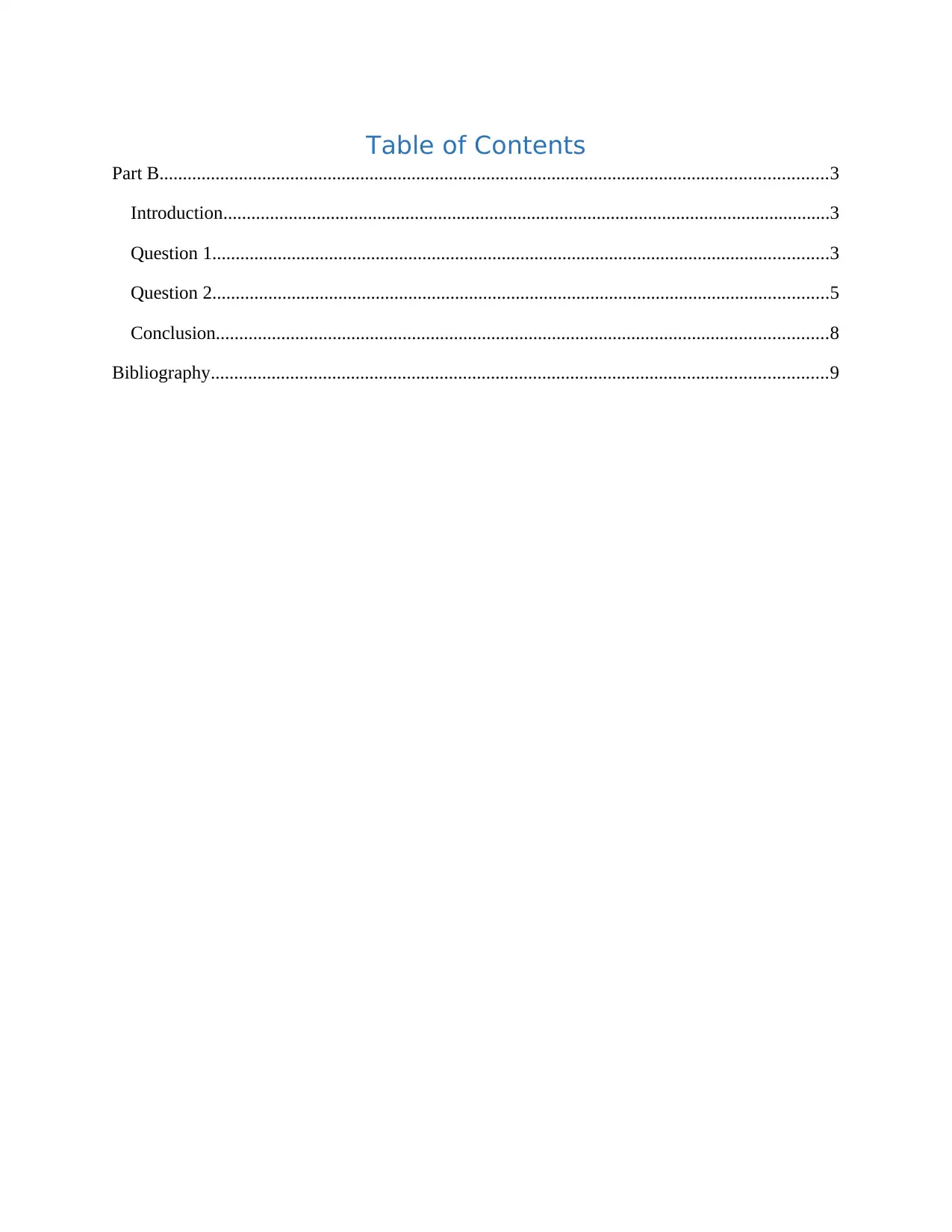
Table of Contents
Part B...............................................................................................................................................3
Introduction..................................................................................................................................3
Question 1....................................................................................................................................3
Question 2....................................................................................................................................5
Conclusion...................................................................................................................................8
Bibliography....................................................................................................................................9
Part B...............................................................................................................................................3
Introduction..................................................................................................................................3
Question 1....................................................................................................................................3
Question 2....................................................................................................................................5
Conclusion...................................................................................................................................8
Bibliography....................................................................................................................................9

PART B
Introduction
The present study is based on the evaluation and analysis of evidence that the PPP and IFE make
unnecessary derivations. The study also covers the ways by which the derivations can be
protected when failure arises from purchasing power parity and international Fisher effect.
Question 1
Under the Purchasing Power Parity, at the equilibrium point, the difference in the percentage of
future foreign currency spot rate from the existing spot rate through an amount that balances in
percentage with the inflation degree of difference among domestic and foreign countries. When
the rate of inflation increases in a country as compared to another country, reduced exports and
increased imports further stress the high-inflation currency of country due to the declining trade
and balances of current accounts. According to the PPP theory, it tries to quantify the
relationship of the exchange rate and inflation1. It is suggested by PPP that the customer’s
purchasing power will be same as when the purchasing products of a foreign nation or in the
domestic nation. In a situation where the inflation with a foreign country is differing from the
domestic country’s inflation, the exchange rate will make an adjustment so as to manage the
balance between purchasing power. Further, Country currencies with the high-inflation rate will
worsen as per the PPP, resulting in the good’s purchasing power in the domestic country against
these countries to be the same.
While, in the situation where there is high-inflation in a specified country, the demand for
foreign goods in the same country will reduce. Moreover, the demand for foreign goods in the
country shall make increment2. Hence, the domestic currency of the same country will
deteriorate, further this tendency shall be continued unless and until the currency is deteriorated
to the point that good of foreign country will not appeal to relative to the goods of domestic
country. The differences in inflation are balanced by the changes in exchange rate.
In accordance with the Fisher Effect, an interest which is free of risk will be inclusive of an
actual return rate and estimated inflation. In case, the requirements by the investor of the similar
1 ROTICH, A.K., 2016. THE EFFECT OF SELECTED MACROECONOMIC VARIABLES ON THE
FINANCIAL PERFORMANCE OF FIRMS LISTED AT NAIROBI SECURITIES EXCHANGE (Doctoral
dissertation, SCHOOL OF BUSINESS, UNIVERSITY OF NAIROBI).
2 Zhao, G., 2014. Dynamic Production Theory under No-Arbitrage Constraints.
Introduction
The present study is based on the evaluation and analysis of evidence that the PPP and IFE make
unnecessary derivations. The study also covers the ways by which the derivations can be
protected when failure arises from purchasing power parity and international Fisher effect.
Question 1
Under the Purchasing Power Parity, at the equilibrium point, the difference in the percentage of
future foreign currency spot rate from the existing spot rate through an amount that balances in
percentage with the inflation degree of difference among domestic and foreign countries. When
the rate of inflation increases in a country as compared to another country, reduced exports and
increased imports further stress the high-inflation currency of country due to the declining trade
and balances of current accounts. According to the PPP theory, it tries to quantify the
relationship of the exchange rate and inflation1. It is suggested by PPP that the customer’s
purchasing power will be same as when the purchasing products of a foreign nation or in the
domestic nation. In a situation where the inflation with a foreign country is differing from the
domestic country’s inflation, the exchange rate will make an adjustment so as to manage the
balance between purchasing power. Further, Country currencies with the high-inflation rate will
worsen as per the PPP, resulting in the good’s purchasing power in the domestic country against
these countries to be the same.
While, in the situation where there is high-inflation in a specified country, the demand for
foreign goods in the same country will reduce. Moreover, the demand for foreign goods in the
country shall make increment2. Hence, the domestic currency of the same country will
deteriorate, further this tendency shall be continued unless and until the currency is deteriorated
to the point that good of foreign country will not appeal to relative to the goods of domestic
country. The differences in inflation are balanced by the changes in exchange rate.
In accordance with the Fisher Effect, an interest which is free of risk will be inclusive of an
actual return rate and estimated inflation. In case, the requirements by the investor of the similar
1 ROTICH, A.K., 2016. THE EFFECT OF SELECTED MACROECONOMIC VARIABLES ON THE
FINANCIAL PERFORMANCE OF FIRMS LISTED AT NAIROBI SECURITIES EXCHANGE (Doctoral
dissertation, SCHOOL OF BUSINESS, UNIVERSITY OF NAIROBI).
2 Zhao, G., 2014. Dynamic Production Theory under No-Arbitrage Constraints.
⊘ This is a preview!⊘
Do you want full access?
Subscribe today to unlock all pages.

Trusted by 1+ million students worldwide

actual return on the goods of same risk and date of maturity, it will make a difference in interest
rate and might occur due to differences in anticipated inflation. It has to be noted that PPP theory
says that movements in the exchange rate are held because of inflation rate differentials.
With the International Fisher Effect, it is said that currencies are having a high rate of interest
will be depreciated due to the high nominal rates and suggests high anticipated inflation. Thus,
investors willing to exploit on the higher foreign interest rate shall gain no higher return as
compared to the earnings made by domestic sources3. International Fisher Effect, at the
equilibrium point, the difference in the percentage of future foreign currency spot rate from the
existing spot rate through an amount that balances in percentage with the nominal interest rate
differences among domestic and foreign countries.
In accordance with the IFE, a higher interest rate of a foreign country shall not be appealing to
investors, as these rates entail high anticipated inflation rates, which in exchange entail possible
depreciates on such currencies. However, some of the investors will still make an investment in
foreign countries wherein there are higher nominal interest rates. This might state that it is
believed made by investors that the estimated inflation rate rooted in a higher nominal interest
rate is overvalued4. On the other side, the potential high inflation will not make considerable
depreciation of the foreign currency, which can take place if sufficient substitute goods where
not accessible elsewhere, or there are other factors that can be balanced the potential inflation
impact on the value of foreign currency.
Thus, derivation actually means deriving the value from considering the goods market value, and
value derives from and is based on the value of the underlying assets like currency and
commodity. While PPP is something different in which the underlying value of assets is
determined by the inflation rate of the country. This compares the currency of different countries
based on market approach. Both the currencies are in PPP and the market’s commodity and
considering exchange rate is charged the same in both countries5. If these both approaches are
used mutually then this can make derivation unnecessary, as the PPP is a sort of manipulative as
3 Lothian, J.R., 2016. Purchasing power parity and the behavior of prices and nominal exchange rates across
exchange-rate regimes. Journal of International Money and Finance, 69, pp.5-21.
4 Majumder, A., Ray, R. and Santra, S., 2017. Sensitivity of Purchasing Power Parity Estimates to Estimation
Procedures and their Effect on Living Standards Comparisons. Journal of Globalization and Development, 8(1).
5 Jacque, L.L., 2014. International Corporate Finance,+ Website: Value Creation with Currency Derivatives in
Global Capital Markets. John Wiley & Sons.
rate and might occur due to differences in anticipated inflation. It has to be noted that PPP theory
says that movements in the exchange rate are held because of inflation rate differentials.
With the International Fisher Effect, it is said that currencies are having a high rate of interest
will be depreciated due to the high nominal rates and suggests high anticipated inflation. Thus,
investors willing to exploit on the higher foreign interest rate shall gain no higher return as
compared to the earnings made by domestic sources3. International Fisher Effect, at the
equilibrium point, the difference in the percentage of future foreign currency spot rate from the
existing spot rate through an amount that balances in percentage with the nominal interest rate
differences among domestic and foreign countries.
In accordance with the IFE, a higher interest rate of a foreign country shall not be appealing to
investors, as these rates entail high anticipated inflation rates, which in exchange entail possible
depreciates on such currencies. However, some of the investors will still make an investment in
foreign countries wherein there are higher nominal interest rates. This might state that it is
believed made by investors that the estimated inflation rate rooted in a higher nominal interest
rate is overvalued4. On the other side, the potential high inflation will not make considerable
depreciation of the foreign currency, which can take place if sufficient substitute goods where
not accessible elsewhere, or there are other factors that can be balanced the potential inflation
impact on the value of foreign currency.
Thus, derivation actually means deriving the value from considering the goods market value, and
value derives from and is based on the value of the underlying assets like currency and
commodity. While PPP is something different in which the underlying value of assets is
determined by the inflation rate of the country. This compares the currency of different countries
based on market approach. Both the currencies are in PPP and the market’s commodity and
considering exchange rate is charged the same in both countries5. If these both approaches are
used mutually then this can make derivation unnecessary, as the PPP is a sort of manipulative as
3 Lothian, J.R., 2016. Purchasing power parity and the behavior of prices and nominal exchange rates across
exchange-rate regimes. Journal of International Money and Finance, 69, pp.5-21.
4 Majumder, A., Ray, R. and Santra, S., 2017. Sensitivity of Purchasing Power Parity Estimates to Estimation
Procedures and their Effect on Living Standards Comparisons. Journal of Globalization and Development, 8(1).
5 Jacque, L.L., 2014. International Corporate Finance,+ Website: Value Creation with Currency Derivatives in
Global Capital Markets. John Wiley & Sons.
Paraphrase This Document
Need a fresh take? Get an instant paraphrase of this document with our AI Paraphraser
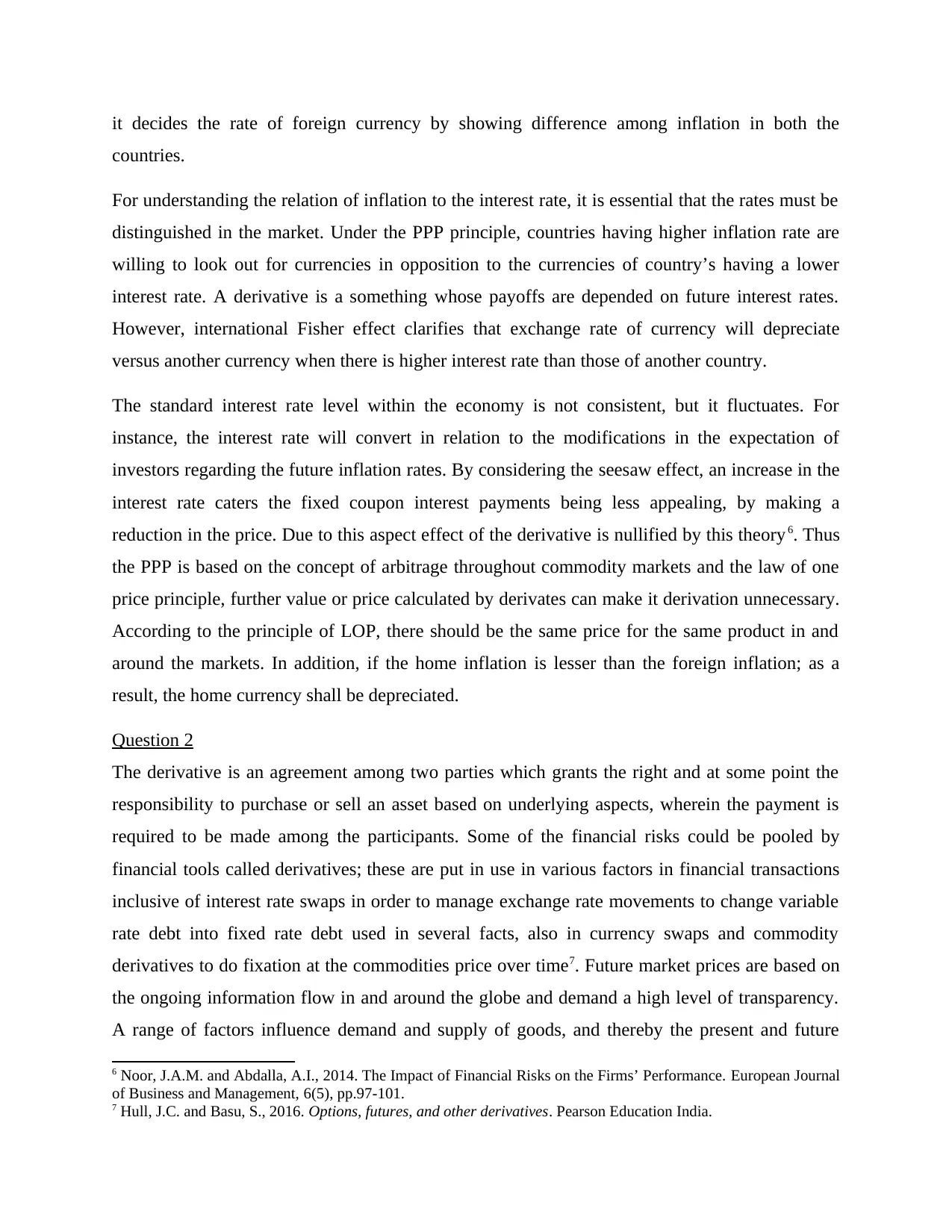
it decides the rate of foreign currency by showing difference among inflation in both the
countries.
For understanding the relation of inflation to the interest rate, it is essential that the rates must be
distinguished in the market. Under the PPP principle, countries having higher inflation rate are
willing to look out for currencies in opposition to the currencies of country’s having a lower
interest rate. A derivative is a something whose payoffs are depended on future interest rates.
However, international Fisher effect clarifies that exchange rate of currency will depreciate
versus another currency when there is higher interest rate than those of another country.
The standard interest rate level within the economy is not consistent, but it fluctuates. For
instance, the interest rate will convert in relation to the modifications in the expectation of
investors regarding the future inflation rates. By considering the seesaw effect, an increase in the
interest rate caters the fixed coupon interest payments being less appealing, by making a
reduction in the price. Due to this aspect effect of the derivative is nullified by this theory 6. Thus
the PPP is based on the concept of arbitrage throughout commodity markets and the law of one
price principle, further value or price calculated by derivates can make it derivation unnecessary.
According to the principle of LOP, there should be the same price for the same product in and
around the markets. In addition, if the home inflation is lesser than the foreign inflation; as a
result, the home currency shall be depreciated.
Question 2
The derivative is an agreement among two parties which grants the right and at some point the
responsibility to purchase or sell an asset based on underlying aspects, wherein the payment is
required to be made among the participants. Some of the financial risks could be pooled by
financial tools called derivatives; these are put in use in various factors in financial transactions
inclusive of interest rate swaps in order to manage exchange rate movements to change variable
rate debt into fixed rate debt used in several facts, also in currency swaps and commodity
derivatives to do fixation at the commodities price over time7. Future market prices are based on
the ongoing information flow in and around the globe and demand a high level of transparency.
A range of factors influence demand and supply of goods, and thereby the present and future
6 Noor, J.A.M. and Abdalla, A.I., 2014. The Impact of Financial Risks on the Firms’ Performance. European Journal
of Business and Management, 6(5), pp.97-101.
7 Hull, J.C. and Basu, S., 2016. Options, futures, and other derivatives. Pearson Education India.
countries.
For understanding the relation of inflation to the interest rate, it is essential that the rates must be
distinguished in the market. Under the PPP principle, countries having higher inflation rate are
willing to look out for currencies in opposition to the currencies of country’s having a lower
interest rate. A derivative is a something whose payoffs are depended on future interest rates.
However, international Fisher effect clarifies that exchange rate of currency will depreciate
versus another currency when there is higher interest rate than those of another country.
The standard interest rate level within the economy is not consistent, but it fluctuates. For
instance, the interest rate will convert in relation to the modifications in the expectation of
investors regarding the future inflation rates. By considering the seesaw effect, an increase in the
interest rate caters the fixed coupon interest payments being less appealing, by making a
reduction in the price. Due to this aspect effect of the derivative is nullified by this theory 6. Thus
the PPP is based on the concept of arbitrage throughout commodity markets and the law of one
price principle, further value or price calculated by derivates can make it derivation unnecessary.
According to the principle of LOP, there should be the same price for the same product in and
around the markets. In addition, if the home inflation is lesser than the foreign inflation; as a
result, the home currency shall be depreciated.
Question 2
The derivative is an agreement among two parties which grants the right and at some point the
responsibility to purchase or sell an asset based on underlying aspects, wherein the payment is
required to be made among the participants. Some of the financial risks could be pooled by
financial tools called derivatives; these are put in use in various factors in financial transactions
inclusive of interest rate swaps in order to manage exchange rate movements to change variable
rate debt into fixed rate debt used in several facts, also in currency swaps and commodity
derivatives to do fixation at the commodities price over time7. Future market prices are based on
the ongoing information flow in and around the globe and demand a high level of transparency.
A range of factors influence demand and supply of goods, and thereby the present and future
6 Noor, J.A.M. and Abdalla, A.I., 2014. The Impact of Financial Risks on the Firms’ Performance. European Journal
of Business and Management, 6(5), pp.97-101.
7 Hull, J.C. and Basu, S., 2016. Options, futures, and other derivatives. Pearson Education India.
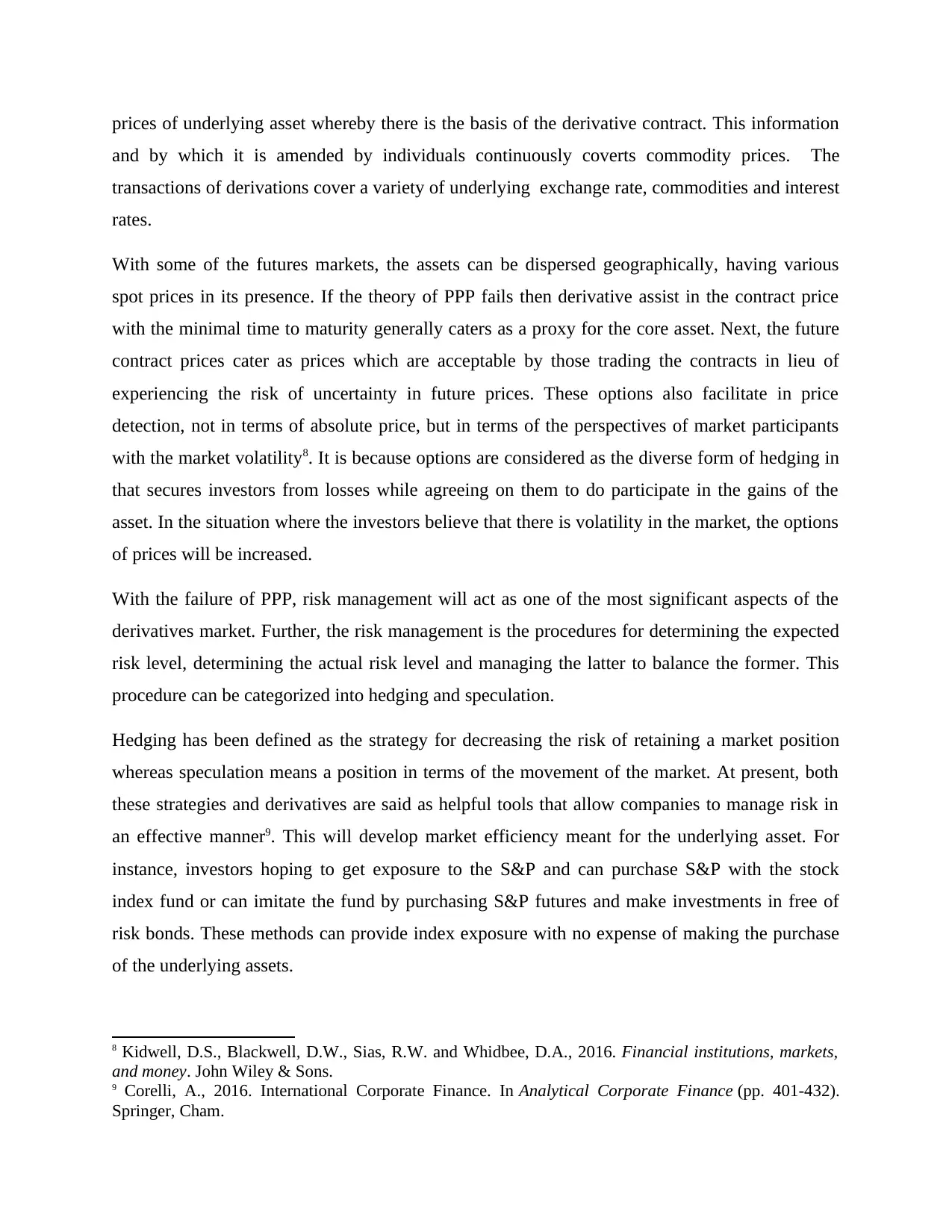
prices of underlying asset whereby there is the basis of the derivative contract. This information
and by which it is amended by individuals continuously coverts commodity prices. The
transactions of derivations cover a variety of underlying exchange rate, commodities and interest
rates.
With some of the futures markets, the assets can be dispersed geographically, having various
spot prices in its presence. If the theory of PPP fails then derivative assist in the contract price
with the minimal time to maturity generally caters as a proxy for the core asset. Next, the future
contract prices cater as prices which are acceptable by those trading the contracts in lieu of
experiencing the risk of uncertainty in future prices. These options also facilitate in price
detection, not in terms of absolute price, but in terms of the perspectives of market participants
with the market volatility8. It is because options are considered as the diverse form of hedging in
that secures investors from losses while agreeing on them to do participate in the gains of the
asset. In the situation where the investors believe that there is volatility in the market, the options
of prices will be increased.
With the failure of PPP, risk management will act as one of the most significant aspects of the
derivatives market. Further, the risk management is the procedures for determining the expected
risk level, determining the actual risk level and managing the latter to balance the former. This
procedure can be categorized into hedging and speculation.
Hedging has been defined as the strategy for decreasing the risk of retaining a market position
whereas speculation means a position in terms of the movement of the market. At present, both
these strategies and derivatives are said as helpful tools that allow companies to manage risk in
an effective manner9. This will develop market efficiency meant for the underlying asset. For
instance, investors hoping to get exposure to the S&P and can purchase S&P with the stock
index fund or can imitate the fund by purchasing S&P futures and make investments in free of
risk bonds. These methods can provide index exposure with no expense of making the purchase
of the underlying assets.
8 Kidwell, D.S., Blackwell, D.W., Sias, R.W. and Whidbee, D.A., 2016. Financial institutions, markets,
and money. John Wiley & Sons.
9 Corelli, A., 2016. International Corporate Finance. In Analytical Corporate Finance (pp. 401-432).
Springer, Cham.
and by which it is amended by individuals continuously coverts commodity prices. The
transactions of derivations cover a variety of underlying exchange rate, commodities and interest
rates.
With some of the futures markets, the assets can be dispersed geographically, having various
spot prices in its presence. If the theory of PPP fails then derivative assist in the contract price
with the minimal time to maturity generally caters as a proxy for the core asset. Next, the future
contract prices cater as prices which are acceptable by those trading the contracts in lieu of
experiencing the risk of uncertainty in future prices. These options also facilitate in price
detection, not in terms of absolute price, but in terms of the perspectives of market participants
with the market volatility8. It is because options are considered as the diverse form of hedging in
that secures investors from losses while agreeing on them to do participate in the gains of the
asset. In the situation where the investors believe that there is volatility in the market, the options
of prices will be increased.
With the failure of PPP, risk management will act as one of the most significant aspects of the
derivatives market. Further, the risk management is the procedures for determining the expected
risk level, determining the actual risk level and managing the latter to balance the former. This
procedure can be categorized into hedging and speculation.
Hedging has been defined as the strategy for decreasing the risk of retaining a market position
whereas speculation means a position in terms of the movement of the market. At present, both
these strategies and derivatives are said as helpful tools that allow companies to manage risk in
an effective manner9. This will develop market efficiency meant for the underlying asset. For
instance, investors hoping to get exposure to the S&P and can purchase S&P with the stock
index fund or can imitate the fund by purchasing S&P futures and make investments in free of
risk bonds. These methods can provide index exposure with no expense of making the purchase
of the underlying assets.
8 Kidwell, D.S., Blackwell, D.W., Sias, R.W. and Whidbee, D.A., 2016. Financial institutions, markets,
and money. John Wiley & Sons.
9 Corelli, A., 2016. International Corporate Finance. In Analytical Corporate Finance (pp. 401-432).
Springer, Cham.
⊘ This is a preview!⊘
Do you want full access?
Subscribe today to unlock all pages.

Trusted by 1+ million students worldwide
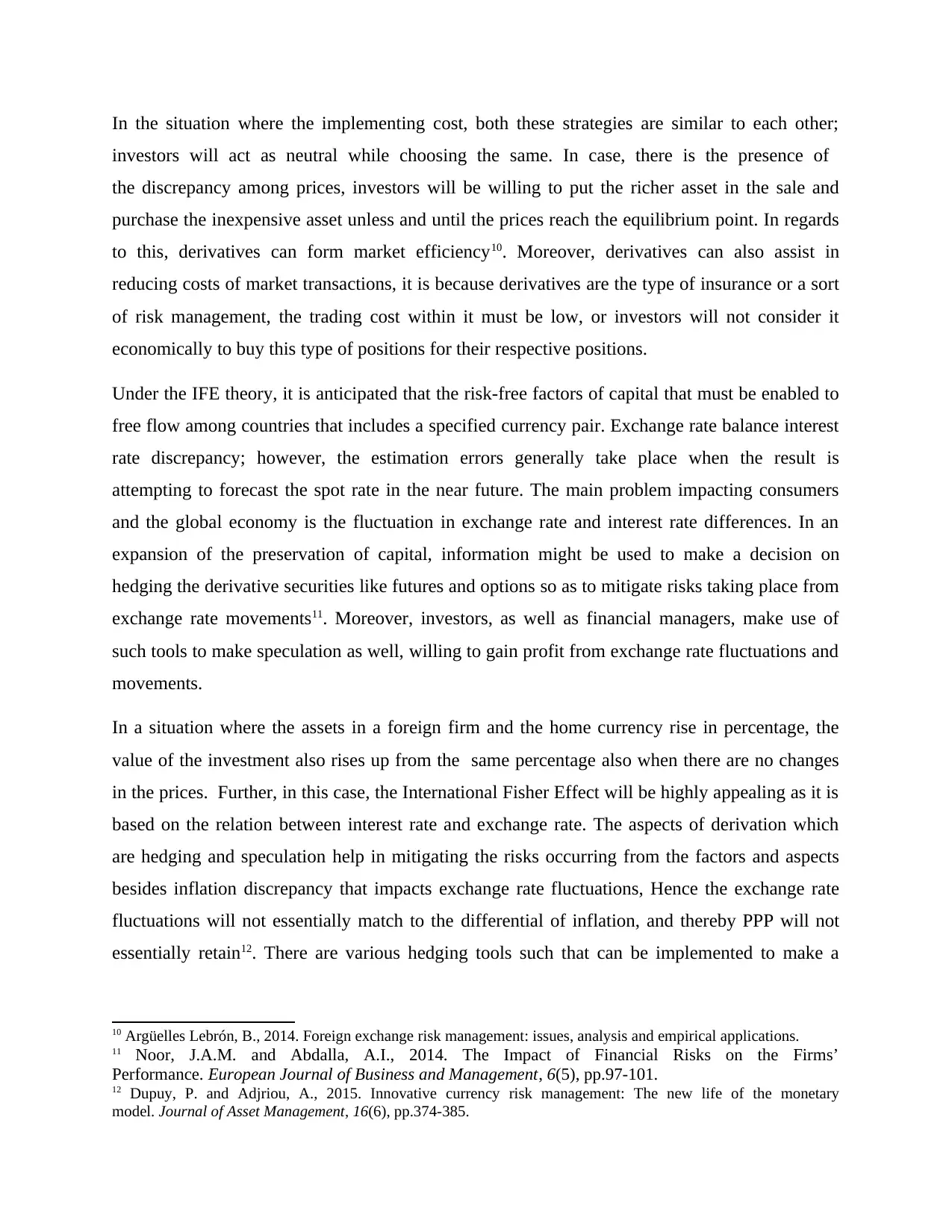
In the situation where the implementing cost, both these strategies are similar to each other;
investors will act as neutral while choosing the same. In case, there is the presence of
the discrepancy among prices, investors will be willing to put the richer asset in the sale and
purchase the inexpensive asset unless and until the prices reach the equilibrium point. In regards
to this, derivatives can form market efficiency10. Moreover, derivatives can also assist in
reducing costs of market transactions, it is because derivatives are the type of insurance or a sort
of risk management, the trading cost within it must be low, or investors will not consider it
economically to buy this type of positions for their respective positions.
Under the IFE theory, it is anticipated that the risk-free factors of capital that must be enabled to
free flow among countries that includes a specified currency pair. Exchange rate balance interest
rate discrepancy; however, the estimation errors generally take place when the result is
attempting to forecast the spot rate in the near future. The main problem impacting consumers
and the global economy is the fluctuation in exchange rate and interest rate differences. In an
expansion of the preservation of capital, information might be used to make a decision on
hedging the derivative securities like futures and options so as to mitigate risks taking place from
exchange rate movements11. Moreover, investors, as well as financial managers, make use of
such tools to make speculation as well, willing to gain profit from exchange rate fluctuations and
movements.
In a situation where the assets in a foreign firm and the home currency rise in percentage, the
value of the investment also rises up from the same percentage also when there are no changes
in the prices. Further, in this case, the International Fisher Effect will be highly appealing as it is
based on the relation between interest rate and exchange rate. The aspects of derivation which
are hedging and speculation help in mitigating the risks occurring from the factors and aspects
besides inflation discrepancy that impacts exchange rate fluctuations, Hence the exchange rate
fluctuations will not essentially match to the differential of inflation, and thereby PPP will not
essentially retain12. There are various hedging tools such that can be implemented to make a
10 Argüelles Lebrón, B., 2014. Foreign exchange risk management: issues, analysis and empirical applications.
11 Noor, J.A.M. and Abdalla, A.I., 2014. The Impact of Financial Risks on the Firms’
Performance. European Journal of Business and Management, 6(5), pp.97-101.
12 Dupuy, P. and Adjriou, A., 2015. Innovative currency risk management: The new life of the monetary
model. Journal of Asset Management, 16(6), pp.374-385.
investors will act as neutral while choosing the same. In case, there is the presence of
the discrepancy among prices, investors will be willing to put the richer asset in the sale and
purchase the inexpensive asset unless and until the prices reach the equilibrium point. In regards
to this, derivatives can form market efficiency10. Moreover, derivatives can also assist in
reducing costs of market transactions, it is because derivatives are the type of insurance or a sort
of risk management, the trading cost within it must be low, or investors will not consider it
economically to buy this type of positions for their respective positions.
Under the IFE theory, it is anticipated that the risk-free factors of capital that must be enabled to
free flow among countries that includes a specified currency pair. Exchange rate balance interest
rate discrepancy; however, the estimation errors generally take place when the result is
attempting to forecast the spot rate in the near future. The main problem impacting consumers
and the global economy is the fluctuation in exchange rate and interest rate differences. In an
expansion of the preservation of capital, information might be used to make a decision on
hedging the derivative securities like futures and options so as to mitigate risks taking place from
exchange rate movements11. Moreover, investors, as well as financial managers, make use of
such tools to make speculation as well, willing to gain profit from exchange rate fluctuations and
movements.
In a situation where the assets in a foreign firm and the home currency rise in percentage, the
value of the investment also rises up from the same percentage also when there are no changes
in the prices. Further, in this case, the International Fisher Effect will be highly appealing as it is
based on the relation between interest rate and exchange rate. The aspects of derivation which
are hedging and speculation help in mitigating the risks occurring from the factors and aspects
besides inflation discrepancy that impacts exchange rate fluctuations, Hence the exchange rate
fluctuations will not essentially match to the differential of inflation, and thereby PPP will not
essentially retain12. There are various hedging tools such that can be implemented to make a
10 Argüelles Lebrón, B., 2014. Foreign exchange risk management: issues, analysis and empirical applications.
11 Noor, J.A.M. and Abdalla, A.I., 2014. The Impact of Financial Risks on the Firms’
Performance. European Journal of Business and Management, 6(5), pp.97-101.
12 Dupuy, P. and Adjriou, A., 2015. Innovative currency risk management: The new life of the monetary
model. Journal of Asset Management, 16(6), pp.374-385.
Paraphrase This Document
Need a fresh take? Get an instant paraphrase of this document with our AI Paraphraser
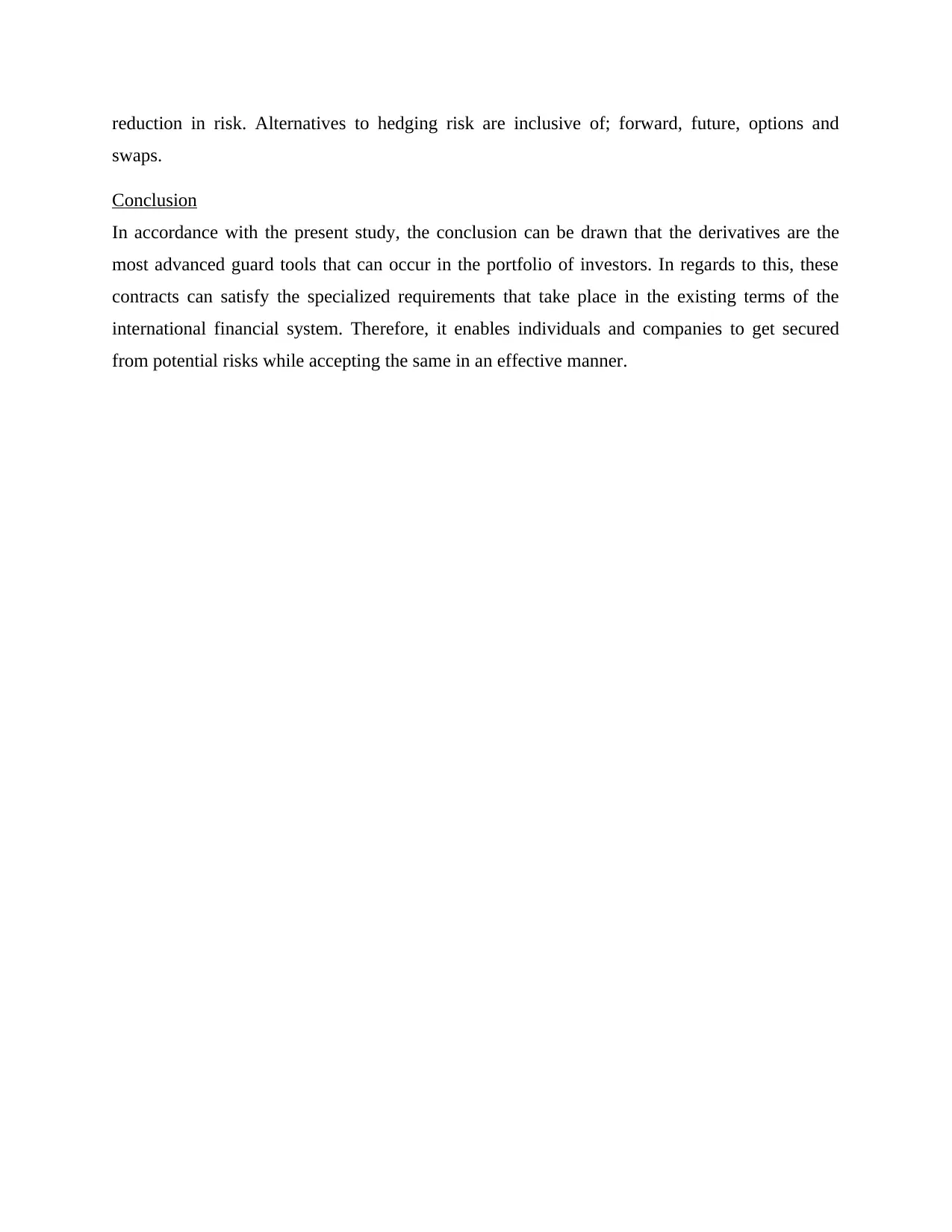
reduction in risk. Alternatives to hedging risk are inclusive of; forward, future, options and
swaps.
Conclusion
In accordance with the present study, the conclusion can be drawn that the derivatives are the
most advanced guard tools that can occur in the portfolio of investors. In regards to this, these
contracts can satisfy the specialized requirements that take place in the existing terms of the
international financial system. Therefore, it enables individuals and companies to get secured
from potential risks while accepting the same in an effective manner.
swaps.
Conclusion
In accordance with the present study, the conclusion can be drawn that the derivatives are the
most advanced guard tools that can occur in the portfolio of investors. In regards to this, these
contracts can satisfy the specialized requirements that take place in the existing terms of the
international financial system. Therefore, it enables individuals and companies to get secured
from potential risks while accepting the same in an effective manner.
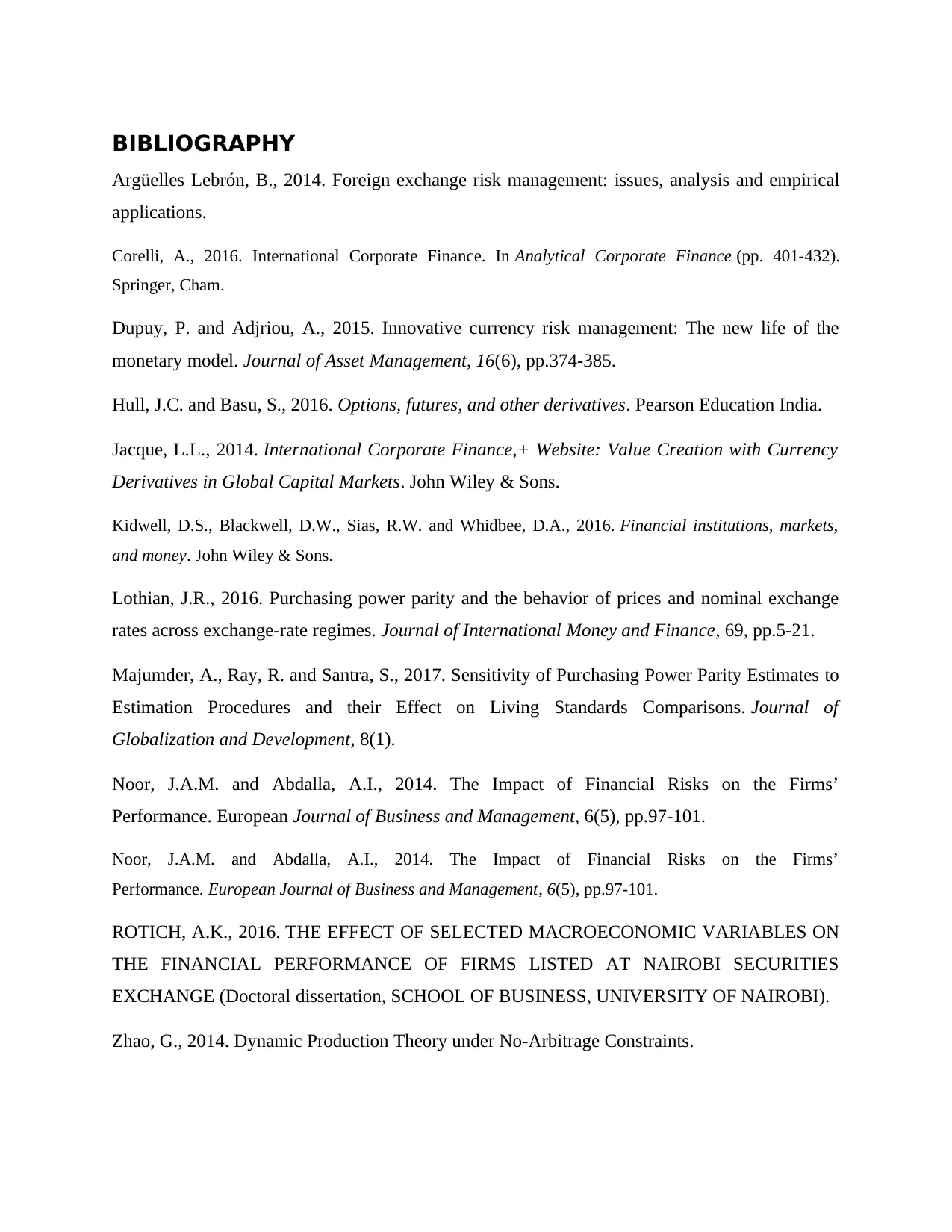
BIBLIOGRAPHY
Argüelles Lebrón, B., 2014. Foreign exchange risk management: issues, analysis and empirical
applications.
Corelli, A., 2016. International Corporate Finance. In Analytical Corporate Finance (pp. 401-432).
Springer, Cham.
Dupuy, P. and Adjriou, A., 2015. Innovative currency risk management: The new life of the
monetary model. Journal of Asset Management, 16(6), pp.374-385.
Hull, J.C. and Basu, S., 2016. Options, futures, and other derivatives. Pearson Education India.
Jacque, L.L., 2014. International Corporate Finance,+ Website: Value Creation with Currency
Derivatives in Global Capital Markets. John Wiley & Sons.
Kidwell, D.S., Blackwell, D.W., Sias, R.W. and Whidbee, D.A., 2016. Financial institutions, markets,
and money. John Wiley & Sons.
Lothian, J.R., 2016. Purchasing power parity and the behavior of prices and nominal exchange
rates across exchange-rate regimes. Journal of International Money and Finance, 69, pp.5-21.
Majumder, A., Ray, R. and Santra, S., 2017. Sensitivity of Purchasing Power Parity Estimates to
Estimation Procedures and their Effect on Living Standards Comparisons. Journal of
Globalization and Development, 8(1).
Noor, J.A.M. and Abdalla, A.I., 2014. The Impact of Financial Risks on the Firms’
Performance. European Journal of Business and Management, 6(5), pp.97-101.
Noor, J.A.M. and Abdalla, A.I., 2014. The Impact of Financial Risks on the Firms’
Performance. European Journal of Business and Management, 6(5), pp.97-101.
ROTICH, A.K., 2016. THE EFFECT OF SELECTED MACROECONOMIC VARIABLES ON
THE FINANCIAL PERFORMANCE OF FIRMS LISTED AT NAIROBI SECURITIES
EXCHANGE (Doctoral dissertation, SCHOOL OF BUSINESS, UNIVERSITY OF NAIROBI).
Zhao, G., 2014. Dynamic Production Theory under No-Arbitrage Constraints.
Argüelles Lebrón, B., 2014. Foreign exchange risk management: issues, analysis and empirical
applications.
Corelli, A., 2016. International Corporate Finance. In Analytical Corporate Finance (pp. 401-432).
Springer, Cham.
Dupuy, P. and Adjriou, A., 2015. Innovative currency risk management: The new life of the
monetary model. Journal of Asset Management, 16(6), pp.374-385.
Hull, J.C. and Basu, S., 2016. Options, futures, and other derivatives. Pearson Education India.
Jacque, L.L., 2014. International Corporate Finance,+ Website: Value Creation with Currency
Derivatives in Global Capital Markets. John Wiley & Sons.
Kidwell, D.S., Blackwell, D.W., Sias, R.W. and Whidbee, D.A., 2016. Financial institutions, markets,
and money. John Wiley & Sons.
Lothian, J.R., 2016. Purchasing power parity and the behavior of prices and nominal exchange
rates across exchange-rate regimes. Journal of International Money and Finance, 69, pp.5-21.
Majumder, A., Ray, R. and Santra, S., 2017. Sensitivity of Purchasing Power Parity Estimates to
Estimation Procedures and their Effect on Living Standards Comparisons. Journal of
Globalization and Development, 8(1).
Noor, J.A.M. and Abdalla, A.I., 2014. The Impact of Financial Risks on the Firms’
Performance. European Journal of Business and Management, 6(5), pp.97-101.
Noor, J.A.M. and Abdalla, A.I., 2014. The Impact of Financial Risks on the Firms’
Performance. European Journal of Business and Management, 6(5), pp.97-101.
ROTICH, A.K., 2016. THE EFFECT OF SELECTED MACROECONOMIC VARIABLES ON
THE FINANCIAL PERFORMANCE OF FIRMS LISTED AT NAIROBI SECURITIES
EXCHANGE (Doctoral dissertation, SCHOOL OF BUSINESS, UNIVERSITY OF NAIROBI).
Zhao, G., 2014. Dynamic Production Theory under No-Arbitrage Constraints.
⊘ This is a preview!⊘
Do you want full access?
Subscribe today to unlock all pages.

Trusted by 1+ million students worldwide
1 out of 9
Related Documents
Your All-in-One AI-Powered Toolkit for Academic Success.
+13062052269
info@desklib.com
Available 24*7 on WhatsApp / Email
![[object Object]](/_next/static/media/star-bottom.7253800d.svg)
Unlock your academic potential
Copyright © 2020–2025 A2Z Services. All Rights Reserved. Developed and managed by ZUCOL.




